Wednesday, 2 June 2010
Distance 22 km
Duration 4 hours 55 minutes
Ascent 324 m, descent 227 m
Map 41 of the TOP100 blue series (or Map 140 in the new lime-green series)
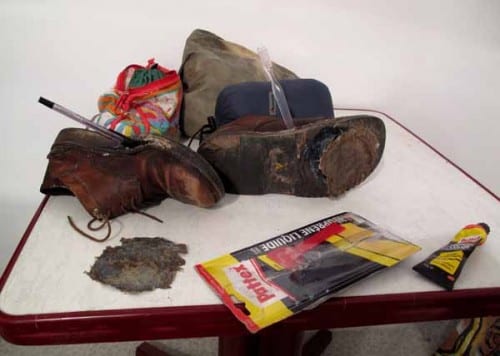
The rain which had hammered on the tent all night had the good grace to stop at dawn and we were able to crawl out into the long wet grass and haul all our gear down to the games room. Our Belgian fellow walker was there too, in much the same miserable state as us, eating a bowl of something unappetising.
She told us that she had walked into the town yesterday and had seen where the blue and yellow pilgrim signs left the church. We hoped to follow them today and get to Bénévent-l’Abbaye more directly than by the GR. We decided not to bother about muesli, but before we left, I stuck the soles of my shoes on for the third time.
The glue had to be applied and then left to dry for ten minutes, keeping the surfaces apart by whatever means, before pressing them together and praying. When this was done, we set off at a slow pace towards the centre, nursing our blistered feet.
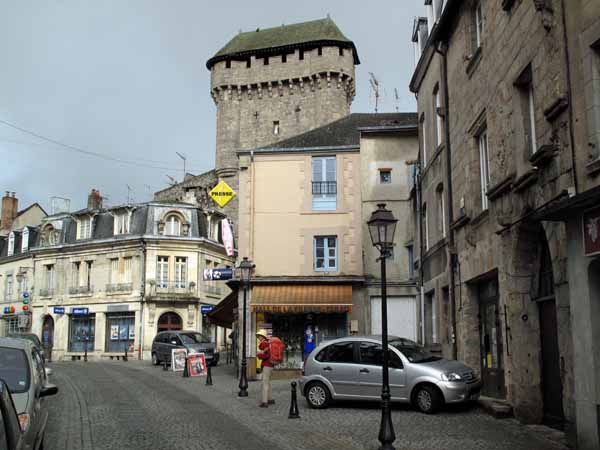
It was a long two kilometres, and at the first boulangerie we stopped and got a baguette, a pain aux raisins and a chausson aux pruneaux (prune turnover). The next thing was to find a bar, but we had to go right through the mighty portal into the church square before we found one, at the top of the sloping expanse.
As our teeth sank into the warm, delectable pastries and the steam rose from our bowls of coffee, all the misery of the camping ground was forgiven and forgotten. The sun was trying to come out, while beyond the lace curtains of the bar rose the great flank of the cathedral, still wet from the rain.
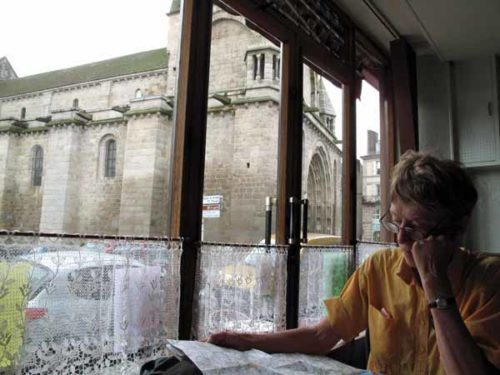
A man came over to us and offered to bring the stamp for our créanciale. He hurried away and returned with the stamp and a mountain of printed information about the town.
He was quite happy to stamp our Topoguide, since we had no créanciale, and it turned out to be the stamp of his café rather than the pilgrim one, not that we minded.
We glanced at the wad of photocopies and learned that the church dated from the eleventh century and had a Roman crypt underneath, which was the origin of the town’s name, meaning “subterranean”. As soon as we were out of the bar we dumped them, true to our first golden rule – “travel light”.

Thanks to the information from our partner in misfortune, we had no trouble finding the pilgrim signs and following them out of town, down curving lanes and over a busy ring road lined with hardware shops and car sales yards.
We were looking for a Weldom store, where we had bought the miraculous shoe-repair glue called Résist-à-Tout on a previous trip, but no such shop was visible so we did not investigate further.
The pilgrim signs led us along a quiet street and we noticed a pair of walkers emerging from a chambre d’hôte ahead of us. We had seen them yesterday, ambling past the school where we were treating our blisters, and then a few hundred metres further on, resting in a park as we went past.

This morning they were ambling again, standing in the road looking vaguely around. We passed them with a polite wave and pressed on, over the railway line and under the autoroute with a slight kink, then picked up the continuation of the suburban road we had been on. Now that it was in the country it was dignified as the D10.
Cycling towards us at this point was a familiar figure – the craggy Dutchman who had shared our rainy night’s camping at Montgivray, and whom we had last seen in Neuvy.
We expected him to be days ahead of us by now, but he had been resting and was setting off today for Saint-Léonard-de-Noblat – it would be another three days before we got there. His route was more to the west and less hilly than the walking path, but longer. We shook hands and he called “Toi toi!” as he sailed away.

The pilgrim route followed the D10 all the way to Bénévent-l’Abbaye, unlike the GR654, which thrashed about in loops and zig-zags, over twice the distance. We agreed with the Friends of Saint-Jacques, that not all roads are bad to walk on.
This one certainly was not. It meandered along between pastures and patches of woodland, with only an occasional car or truck going past. We caught up to our Belgian friend and passed her while she was taking off her jacket.
Approaching Saint-Priest-la-Feuille, all we could see was the handsome church and a few houses, but when we rounded the corner, there was a little square with a bus stop, a war memorial and a bar-restaurant.
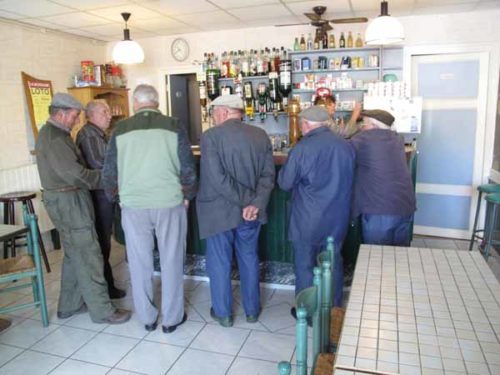
We rushed towards the latter like shipwrecked sailors, although it was only an hour and a half since we had been in the bar at la Souterraine.
Inside (it was too cool to sit on the vine-covered terrace), the bar was being propped up by a group of elderly dwarves in jackets and berets, the tallest of whom would have reached my ear. It was probably the result of childhood starvation during the war, or just after it. While we sat over our coffees, the ambling walkers came in and I went over to make their acquaintance.
They were Germans, doing the pilgrimage in stages. This year they were going from Saint-Amand-Montrond to Limoges. Meanwhile the Belgian woman was in the bus stop outside, swigging from a water bottle, either too poor or too pure to visit the bar.
When we set off again, Keith stopped to change out of his long trousers, but I kept mine on. It was the first time that Keith had walked in longs this year, so cold had he been during the night. I, on the other hand, had hardly worn shorts at all.

After a while we came to the bridge at la Côte and caught up once again with the Belgian pilgrim, who was striding along with her two walking poles like a cross-country skier. We decided that it would be good to take a short cut to Chamborand on the GR, when it crossed the road at the top of the rise.
We passed our friend, who had stopped for a snack (in another bus stop), but unfortunately we took the wrong road up the rise and consequently, when we turned off on the GR, we had a long march through muddy forest lanes, wondering where we were, before we emerged at the top of the village.
It was only when we were sitting having lunch outside the cemetery that we worked out why the track had seemed so at odds with the map.
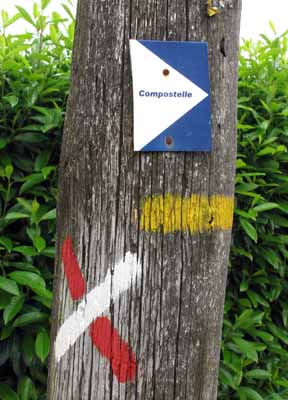
Our feet were sodden after this foolish excursion and we took off our shoes to try to dry them out, but the agony of getting them on again and the first few hundred metres of walking made us wonder whether it was worth it. After that, the pain of our blisters turned to a sort of aching numbness for the rest of the distance.
We hobbled down through the streets to the church and the ruined tower, then got back on the D10 with relief. A short time later we passed our Belgian friend, who had got ahead of us by staying on the road, even though she was a much slower walker than us.

The countryside got hillier and there was a big ascent to Bénévent-l’Abbaye. We were starting to tire by the time we reached the streets, but we continued to climb.
Seeing a hotel, we went in and discovered that we could have a room for €50 (there was no camping ground in this village). We pressed on to the centre of town, a single street of shops at the top of the hill, next to the abbey church.

It was time for coffee. In the bar we were interrogated by some of the other customers and when they found we were Australian, one of them exclaimed “Jack Brabham! Mark Webber!” He was a car-racing enthusiast and seemed to give us the personal credit for the triumphs of our fellow countrymen.
There were no other hotels in the place, so we descended to the one we had seen and booked in. The man taking our details had a slight variation on the familiar pleasantry (“You’re from Australia? Did you walk or swim?”). He said, “You must have walked on water, like that man two thousands years ago”.
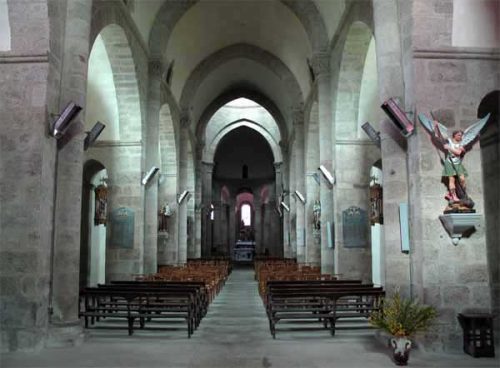
The hotel was old and creaky, although charmingly decorated. Our host led us up to a dark corridor, where he struggled with the lock, then flung the door open triumphantly to reveal a chaotic mess – the room had not been made ready. “Ce n’est pas faite!”, he shouted angrily at this wife. We had to wait in a sitting room downstairs while she dashed up and down with mops and armfuls of linen.
The next time we saw the room it was immaculate. From the window there was a pleasant view over the farmland that we had just traversed, and the bathroom was spacious, with a real bath in which we luxuriated, to the detriment of our blisters but the good of everything else. The rest of the afternoon passed delightfully in sleep.
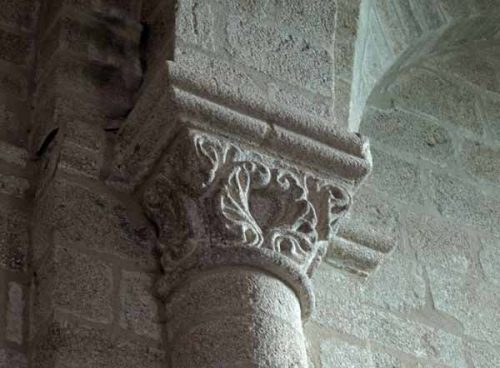
Towards evening we limped back up the street and wandered about in the abbey church. As early as the twelfth century, Bénévent-l’Abbaye was an important staging point on the way of Vézelay, requiring pilgrims, then and now, to make the strenuous ascent, only to lose all the hard-won height the next day.
After a brief look round we retired to the bar for apéritifs. Next door was a little supermarket and we bought a large stock of lunch food, as we had eaten our last few scraps and were worried that we would be obliged to have a picnic at les Billanges tomorrow night.
For dinner we ate in the hotel dining room. When we entered, we saw the German walkers already onto their second course.

Another table was occupied by seven middle-aged French women and one man. They all had dyed hair, mahogany and jet black being popular, except for the man, who had none – he was as bald as an egg.
We had salads to begin with – Périgord and fermière – and then steak with sautéed potatoes and spinach, which made a fine meal, rounded out with bread and wine.
The round-faced young wife was our waitress and the husband was probably the cook. The luxury of just walking upstairs to bed, instead of traipsing a kilometre or more, was not lost on us.
Previous day: Éguzon to la Souterraine